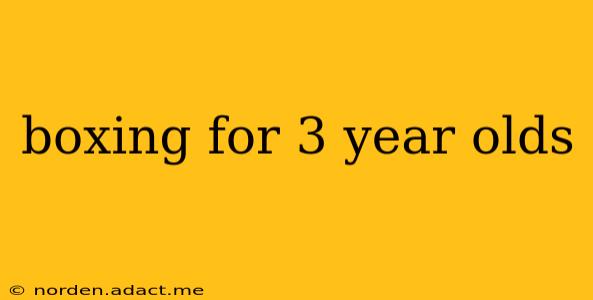Introducing boxing to 3-year-olds might sound unusual, but with the right approach, it can be a fantastic way to foster physical development, coordination, and social skills. Forget the image of intense sparring; this is about introducing the basic elements of boxing in a playful, age-appropriate manner. This isn't about creating future champions, but about nurturing a love for movement and building a solid foundation for future physical activity.
Is Boxing Safe for 3-Year-Olds?
This is a crucial question, and the answer is a qualified "yes," but with significant caveats. Traditional boxing training, with sparring and intense contact, is absolutely unsuitable for this age group. Instead, focus should be on playful activities that mimic boxing movements without the risk of injury. A qualified instructor experienced with young children is essential. The emphasis should always be on fun, safety, and development, not competition.
What Activities are Suitable for 3-Year-Olds?
Forget heavy bags and sparring matches. Here’s what a boxing class for 3-year-olds should look like:
- Movement Games: Think games that encourage basic footwork, like hopping, skipping, and running. These build coordination and agility, which are fundamental to boxing.
- Shadow Boxing: This involves practicing punches and footwork without any equipment. Keep it slow, simple, and fun. Focus on correct form rather than speed or power.
- Punching Bags (Light and Soft): Use extremely lightweight and soft punching bags designed for toddlers. The focus is on rhythm and controlled movements, not forceful punches.
- Obstacle Courses: Navigating simple obstacles encourages coordination, balance, and agility – all crucial for boxing.
- Musical Activities: Incorporating music into the training can make it more engaging and fun. Simple boxing moves can be synchronized with music.
What are the Benefits of Boxing for 3-Year-Olds?
While not a direct path to professional boxing, introducing these elements offers various developmental benefits:
- Improved Coordination and Balance: The activities enhance hand-eye coordination, balance, and overall motor skills.
- Increased Physical Fitness: Playful boxing exercises improve cardiovascular health and overall fitness levels in a fun way.
- Enhanced Gross Motor Skills: Jumping, running, and throwing improve large muscle group coordination.
- Discipline and Focus: While play-based, the structured nature of the classes can aid in developing focus and attention span.
- Social Skills Development: Working in groups encourages interaction and collaboration with peers.
How Can I Find a Suitable Boxing Class for My 3-Year-Old?
Researching reputable programs is key. Look for classes explicitly designed for toddlers and preschoolers. Ask about the instructor's experience with this age group and their safety protocols. Observe a class if possible to gauge the atmosphere and teaching methods. Ensure the class prioritizes fun, safety, and development over competition.
What Equipment is Needed for Boxing Classes for 3-Year-Olds?
The equipment should be age-appropriate and focus on safety. Expect soft, lightweight punching bags, open spaces for movement, and possibly some simple gymnastic equipment for obstacle courses. Avoid anything hard or heavy that could cause injury.
Is it Better Than Other Activities?
Boxing for 3-year-olds isn't necessarily "better" than other activities like swimming or gymnastics. The best choice depends on your child's interests and personality. The advantage of boxing-inspired activities is the unique combination of coordination, fitness, and discipline delivered in a fun and engaging manner.
This playful introduction to boxing concepts can be a fantastic way to get your 3-year-old active, engaged, and learning fundamental skills that will serve them well in life. Remember, safety and fun should always be the top priorities.
